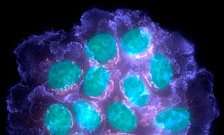(Medical Xpress) -- Researchers based jointly at King’s College London and the Cancer Research UK London Research Institute, together with collaborators at Yale University have found that a type of immune cell, called a Langerhans cell, can facilitate development of skin cancer caused by exposure to harmful synthetic toxins in the environment.
Such immune cells compose a large population in human skin, with intriguing implications for human carcinogenesis related to our environment.
Ironically, Langerhans cells and analogous “dendritic cells” found in other tissues are commonly thought to play a part in the body’s natural defences against cancer, and there are active clinical protocols to upregulate them in certain cancer treatments. So the researchers say the findings are surprising and could have implications for how some cancers are treated in the future.
Epithelial cells, which line the body’s surfaces, are exposed to potentially cancer causing damage every day, such as the effects of UV light, tobacco smoke, food products, and industrial pollution.
To better understand the role of the body’s immune cells in the development of cancer in epithelial cells, the researchers looked at how Langerhans cells deal with damage that can cause skin cancer, and their findings are published in the journal, Science.
The team carried out initial studies in mice, employing a widely-used animal model of chemically-induced skin cancer, or Squamous Cell Carcinoma. They found that mice deficient in Langerhans cells were completely resistant to DNA damage caused by synthetic toxins in epithelial cells and did not develop skin cancer.
The researchers then carried out similar tests in human Langerhans cells, donated by several patients via the National Institute for Health Research (NIHR) comprehensive Biomedical Research Centre (BRC) at King’s College London and Guy’s and St Thomas’ NHS Foundation Trust. The team saw the same effects in the human tissue as that seen in the mice.
Professor Adrian Hayday, based both at King’s College London and Cancer Research UK’s London Research Institute, said: ‘Langerhans cells may activate immunoprotective components of the immune system and so are often regarded as useful in preventing cancer. Here we have actually shown that the opposite is also true – they can play a role in facilitating development of the disease.
‘It is seldom recognised that Langerhans cells are primarily ‘scavenging garbage collectors’, that identify and try to break down harmful compounds. They successfully deal with natural toxins that we come into contact with all the time, such as many in food, but they cannot deal well with some common synthetic toxins from sources such as industrial air pollution.
"This study showed that when these cells attempt to process synthetic toxins, their role changes and their attempt to break down these toxins instead creates even more harmful carcinogenic products that spread to neighbouring cells.
"This study provides vital insight into the role Langerhans cells play in cancer – what is normally your body’s natural way of dealing with harmful compounds becomes harmful when dealing with synthetic toxins. We need to take these findings into account when exploring the manipulation of these specific immune cells for future cancer therapies."
Dr. Safia Danovi, senior science information officer at Cancer Research UK, said: ‘We’re used to thinking that cancer arises from one rebel cell working alone, but this research challenges that view and shows that the immune system can sometimes trigger skin cancer when the skin is exposed to certain toxins. So although immune cells usually help protect us against diseases, the system isn’t foolproof and things can go wrong. We need to study this glitch and perhaps, in the future, we’ll be able to harness this knowledge to help cancer patients.’
Provided by King's College London




















